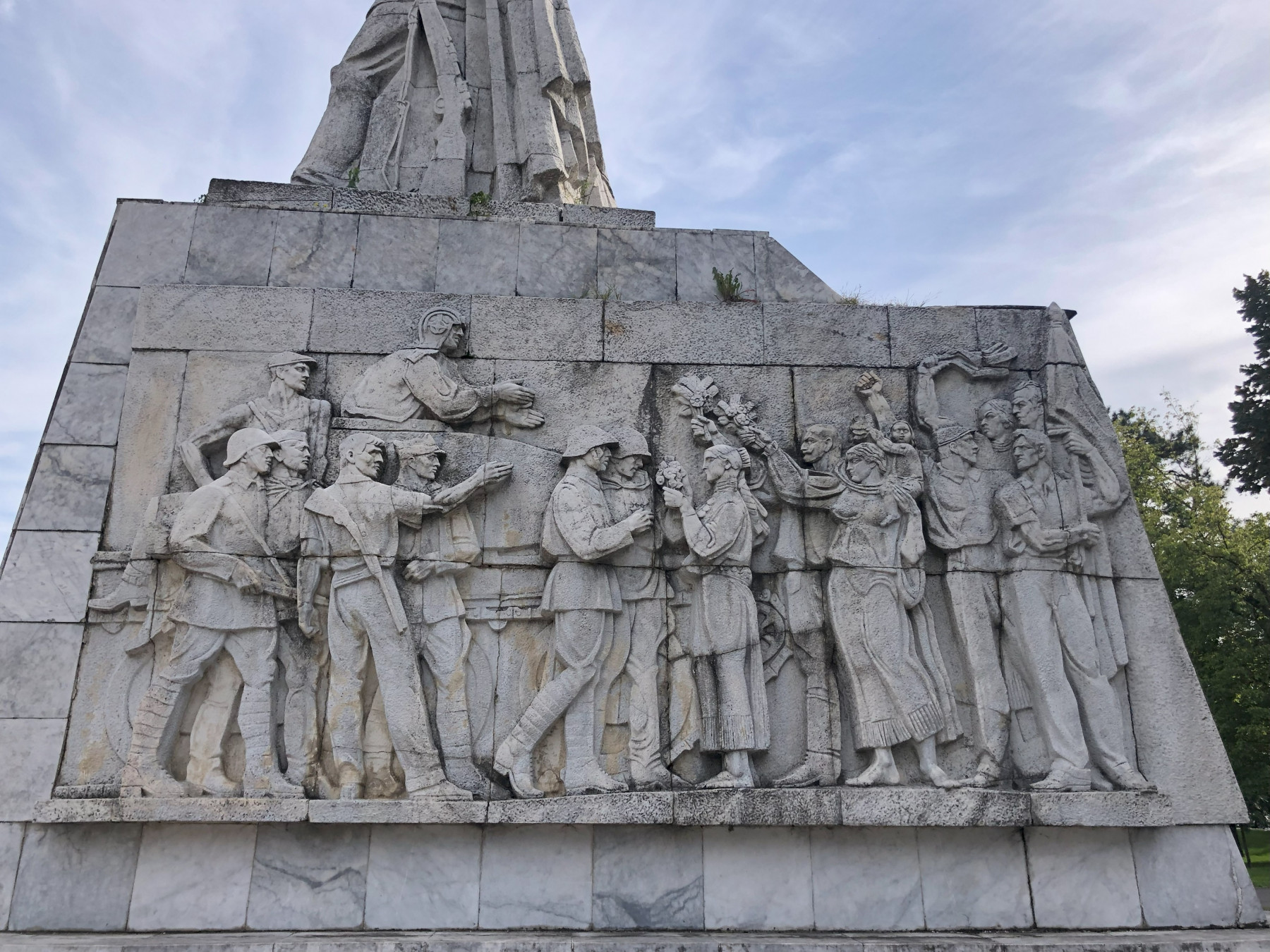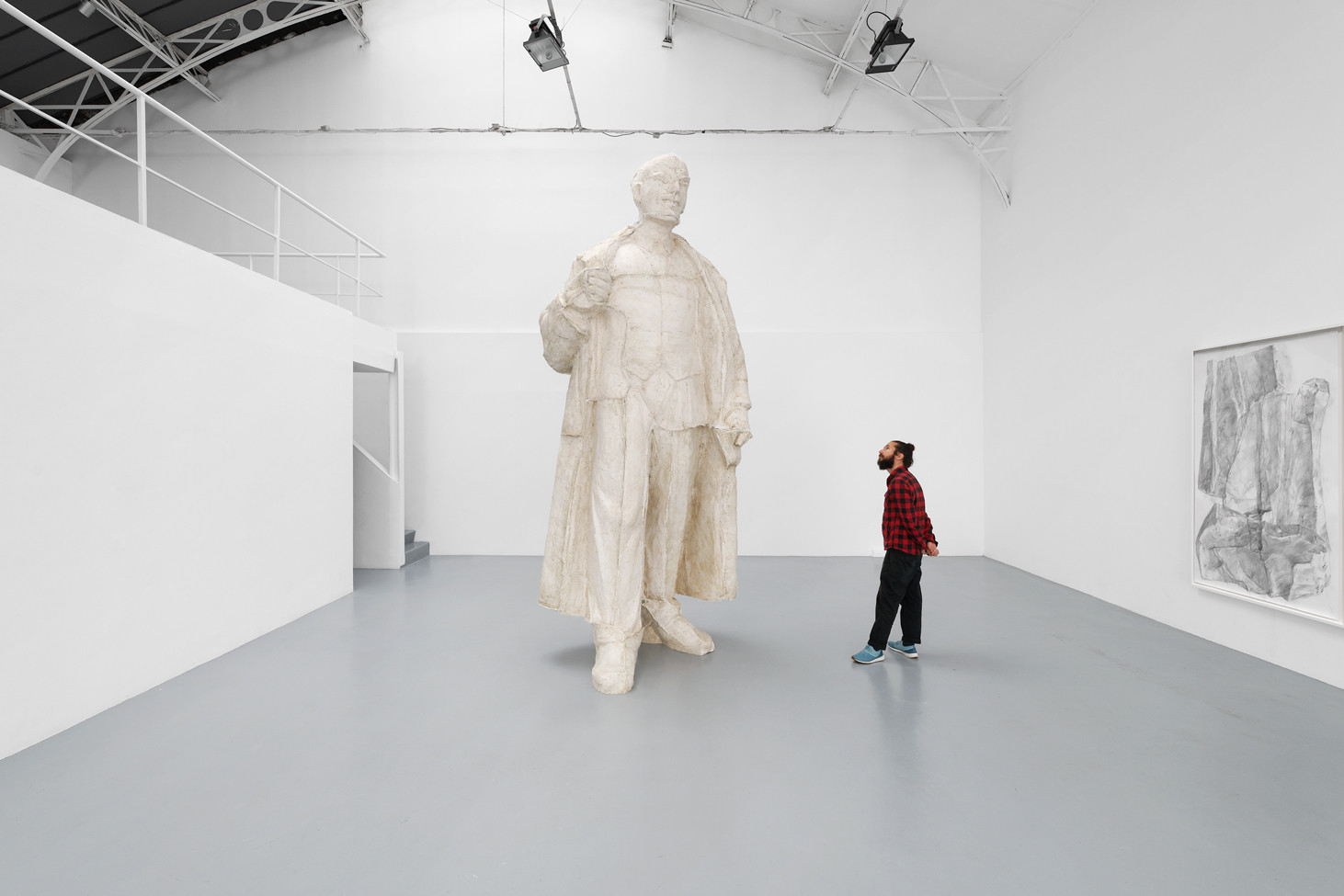Ciprian Mureşan and Şerban Savu’s Revisions of Memory
by Teodora Talhoș

Ion Vlad, Liberating Soviet Soldier, marble monument, Timișoara, photo: Teodora Talhoș.
Amid the escalation of the war in Ukraine and the realization that the era of totalitarian regimes in Europe is sadly not long gone, a debate about public monuments of Soviet times in former socialist countries has re-emerged.
Usually, every big city in the former USSR and the satellite states has at least one large sculpture in the center, representing the "heroism” of the Red Army and praising a Communist leader of the oppressive regime. On the one hand, while some of them could be indeed considered impressive pieces of art, the toxic ideology inherent in them makes it difficult to separate the form from the meaning. On the other hand, having occupied such representative places in the middle of the cities, these monuments have grown to be integrated parts of the landscape, to which citizens have an emotional connection. A personal example: right in the middle of the main park in Timișoara, Romania, one can find the impressive white marble memorial for the "Liberating Soviet Soldier”, created in 1962 by artist Ion Vlad. An inscription on the side of the monument states that glory should be brought to the Romanian soldiers who fought for freedom against Bolshevism and fascism. Of course, the text is historically inaccurate (the Romanian army fought both against and for Nazi Germany and the Soviet Union). The text represents a reiteration of the inscription before the revolution, which mentioned the fight against fascism (but not Bolshevism). Leaving aside the historical and ideological connotations, the statue served as a reference point for whole generations of citizens. Both me and my mother used to play here as children three decades apart, as the large statue was offering not only comforting shade in the summer, but also potential for interesting discoveries. Not knowing much about war and the background of the reliefs, I liked to make up stories in my mind about each figure’s life, from the women offering flowers, to the sturdy soldiers and serious-looking men holding flags. The abolition of such a representative monument would therefore mean a disruption in the fabric of collective memory in both objective and emotional terms.

Şerban Savu, The Steelworker, 2023, oil on canvas, courtesy of the artist.
While the discussions about dealing with a problematic cultural heritage might be relatively new in the Romanian context, there were some artistic attempts in the past to reconsider it. For example, a series of statues (or anti-monuments) were created for a pedestal in Bucharest on which a larger-than-life statue of Lenin stood for 30 years before it was dismantled in 1990. The project, titled Proiect 1990 started in 2010 and lasted for four years. 20 artists used their works to comment on the crisis in which Romanian society found itself (and still finds itself) after the fall of communism, criticizing the corruption of the political class and the prevailing consumerism, that is typical of formerly impoverished societies. Many of the installations involved the viewers, encouraging them to actively engage with the art and, implicitly, with the public space, which led to a critical examination of the shared history and the traces left behind by it. At the end of the project, the vivacious interventions were replaced by a 100-ton steel sculpture representing freedom – a static, “official” statue that lacks the social integration and liveliness as well as the reflective potential of the earlier installations.

Ciprian Mureşan, Incarnation, 2020, resin, 399 x 165 x 143 cm, courtesy Galerie Éric Hussenot, © photo: Éric Simon.
Having recently moved to Timișoara, the starting point of the violent anti-communist revolution, I often realize that the trauma of the past and especially the revolution, whose consequences disappointed many, are still an open wound. The question of how to tackle this delicate and highly complex matter with the help of art is one that often preoccupies me. Following these reflections, I recently visited two Cluj based artists, Ciprian Mureșan and Șerban Savu, in their studio.
Establishing themselves more than 15 years ago as part of the buzzing, emerging art scene of Cluj, the unofficial capital of Transylvania, the two artists have grown to international reputation since then. Sharing a similar background – they both studied at the same University of Art and Design in Cluj and belong to the first post-communist artist generation after experiencing the harsh transition period of the 1990s – Savu and Mureșan work in the same studio, an old and elegant apartment close to the railway station. They chose not to move abroad in search for better opportunities, as many other artists and ambitious young people did, but to stay and create in the difficult, but inspiring Romanian context.

Ciprian Mureşan, Incarnation (detail), 2020, resin, 399 x 165 x 143 cm, courtesy Galerie Éric Hussenot, © photo: Éric Simon.
In his works, Ciprian Mureşan often approaches the unwanted and traumatic legacy of communism and social realism from a conceptual and witty perspective. Referencing the above-mentioned monumental sculpture of Lenin in Bucharest, Mureşan created a reinterpretation called Incarnation in 2020. The 4-meter statue was made based on reproductions of the destroyed sculpture, starting from small scale casts that were enlarged in the course of the process and combined to form the large, final sculpture. The result resembled a monstrosity, a huge creature made of resin, with deformed features marked by deep cuts and a disproportionate body. The sight of the imposing, but also intentionally clumsy and, due to its material, fragile sculpture made me think of all the Lenin monuments that still adorn Russian cities today. Not so long ago, even in Romania, it would have been considered sacrilege and an offense against the state not to depict a communist ruler as an ideal figure with heroic features and strong stature. In this peculiar anachronism, in which the past is neither acknowledged nor dealt with in some places, while in others it is questioned and dismantled, Mureşan’s work is subtly even more subversive.

Ciprian Mureşan, Echoes, 2023, photo: Teodora Talhoș.
During my stay in Cluj, I also visited Mureşan’s solo show in Aluvial, a newly opened independent art space. Titled None of it is real, but it’s based on events that took place, the exhibition featured papier-mâché sculptures of easily recognizable and idealized proletarian workers. However, the figures appeared to be divided in half, as only the upper part of their bodies was shown on low pedestals. Their monumentality was thus undermined and they received the viewer at eye level with interrogating glances. Not only the art work but also the visitor was the one being observed. Cameras obscuras were hidden in the heads of the sculptures, which were activated each time the sheet of paper covering their eyes was removed in order to take photographs of the space. As a commentary on both content (ideology) and form (materiality), Echoes (2023) posed questions about the mythologized protagonists of the socialist era and what has happened to them since the fall of communism. From celebrated heroes, they have become invisible figures on the margins of existence, feeding the machinery of capitalism.

Şerban Savu, The City is Being Built and Flourishes 1, 2017, oil on canvas, 148 x 185 cm, courtesy of the artist.
The topic of today’s workers and the future of socialist realism is also addressed in Şerban Savu’s practice. An erudite painter and, more recently, a mosaicist, Savu’s artworks surprise the viewer with their apparent calm and lack of tension. Rejecting faster media such as photography, Savu meticulously paints scenes of normal life, which seem to be in suspension in the post-socialist transition period. To someone who grew up in the Eastern bloc context, his works feel incredibly familiar: from women drying laundry in the front garden, to people holding a May Day picnic, to construction workers enjoying their break. Although the artworks evade direct criticism or a radical message and it is left to the viewer to add a personal interpretation to them, Savu’s preoccupation with the meaning conveyed in the artworks of socialist realism is evident. Overlaying art historical references with the artist’s own careful observation of the world around him, the paintings often have a pensive and magical atmosphere. For example, Re-enactment (2016) illustrates a room in a seemingly abandoned building with a large fresco showing a colorful mosaic of workers conducting their duties. The fresco is being painted by an artist with his back turned to us, the viewers – a self-portrait. The City is Being Built and Flourishes 1 (2017) depicts a waiting room of a train or bus station waiting room dominated by a monumental colorful fresco divided into geometric and floral motifs interwoven with scenes from an ideal city where people talk and sing together. At the foot of the fresco you can see people actually waiting for something, each one of them bored and trapped in their own solitude, without communicating with each other. The promise of the past is not fulfilled in the present.
With his quiet plea for the preservation of the artworks of socialist realism, which he puts on a level with, let’s say, Pompeii mosaics, Savu makes the viewer flinch: you are not only confronted with the ephemerality of grandiose ideologies, but also with your own mortality.
In the end, the question of how to deal with a painful past remains open. There is no right answer, especially when the past is closer than it seems.

Şerban Savu, Re-enactment, 2016, oil on canvas, 152 x 220 cm, courtesy of the artist.